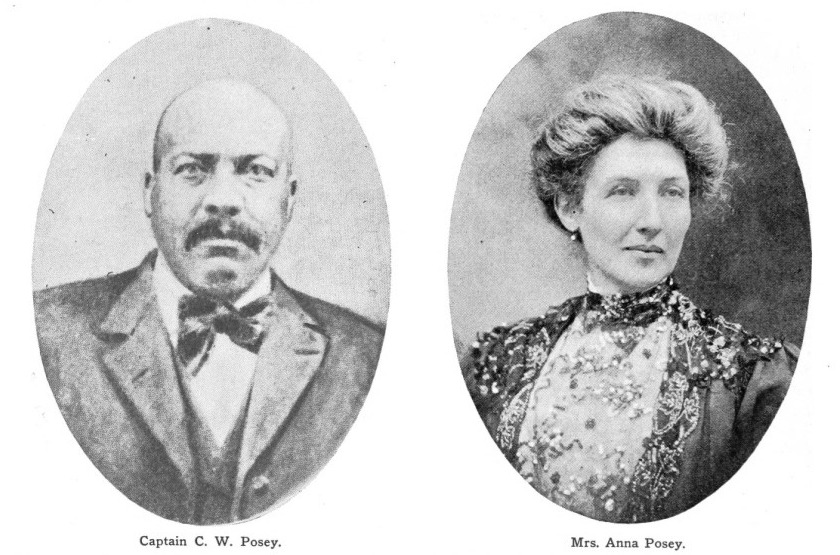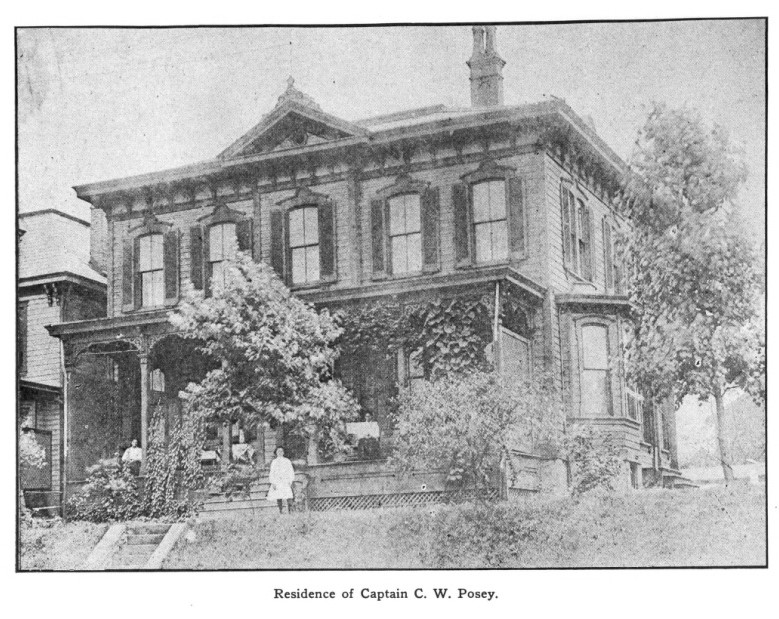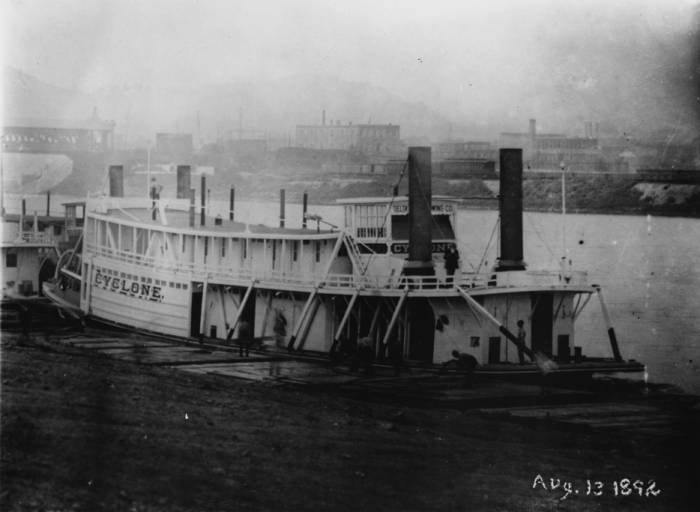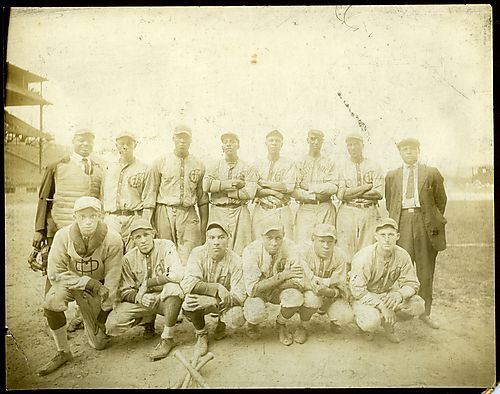The three rivers of Pittsburgh, the Allegheny, the Monongahela, and the Ohio, have always been integral to the city's success. During the Gilded Age, this was particularly true because of the commerce that literally flowed through these bodies of water. While industrialists like Henry Clay Frick and Andrew Carnegie utilized these rivers for their steel mills, there was another figure in Pittsburgh who made his living on the water. Cumberland Posey was an African American businessman who found substantial success with his steamboat business and later investments in and around Homestead, PA.

Cumberland Posey (left), and his wife Anna Posey (right). Photos courtesy of Pennsylvania Negro Business DIstrict, 1910.
Cumberland Posey was born in 1858 to Mary Elizabeth Fontaine and Alexander Posey, an enslaved family in Maryland. His mother passed away early in his life, and after Emancipation during the Civil War, his father became a minister of the African Methodist Episcopal Church. The family later moved to Virginia and then to Ohio, where Cumberland started working on boats, a common occupation for African American men who lived in river towns. Some accounts have him working first by sweeping the decks, whereas others report his job as a fireman. At this point, Mr. Posey set his sights on becoming an engineer, a rarity for African American men, who were generally hired for more menial and laborious occupations in the 19th century. To reach his goal and acquire the knowledge needed to pursue it, he continued to work jobs on various steamboats, slowly gaining the experience and connections he needed. This process was made even more difficult because of the heavy discrimination he encountered. Yet, his hard work and planning paid off: he acquired his license as a second engineer in 1877, becoming the first Black man in America to do so. Posey’s reputation followed the flow of the Ohio River, and soon he was known as Captain “Cap” Posey. While traveling along the river, he met his future wife, Anna Stevens, in Athens, Ohio. They were married in 1883 and stayed in Ohio until they ultimately moved to Pennsylvania and settled in Homestead, a city on the rise due to the steel industry.

The home of Cumberland Posey in Homestead, PA. Photo courtesy of Pennsylvania Negro Business Directory, 1910.
The move to Pennsylvania was extremely fortuitous for his business ventures. Soon after getting his engineering license, he started amassing wealth in different industries. He founded the Posey Steamboat Company, which built over 40 steamboats, and the Delta Coal Company. Both of his companies were highly successful. Posey was also one of the founding members of the Posey and Myers coal merchants’ organization. In addition to his companies, he became one of the largest individual property holders in Homestead as part of a real estate venture. However, in 1897, Posey became embroiled in controversy. In June of that year, he and his business partner were arrested for defrauding the Shoenberger Steel Company by selling them a lower-quality coal than they were paying for. The two were released on bail for $3,000 and were eventually found guilty.
Because of Mr. Posey’s success in these industries, he encountered the other industrialists of this time, including Henry Clay Frick. After the Homestead Lockout in 1892, Carnegie and Frick refused to rehire most of the workers who had gone on strike. Posey helped recruit new Black workers and presented the Carnegie businesses as a friendly face to the growing Black community.

One of Cumberland Posey's notable boats, the Cyclone. Photo courtesy of the Cincinnati Public Library's Inland Rivers collection.
Cumberland Posey’s legacy extends far beyond the wealth he built as a businessman. He was also actively involved in many other organizations. He notably became one of the first investors in the Pittsburgh Courier, once the country’s most widely circulated Black newspaper. He was also on the Board of Directors for the Warren ME Church in the Hill District and served as president of the Loendi Club, one of Pittsburgh's oldest literary clubs. At the time of his death in 1925, he was considered “one of the richest men in the city.” He was survived by two sons and one daughter and was buried with full Masonic honors in Homestead Cemetery.
Cumberland Posey's son, Cum Posey, Jr. (pictured front row, second from left), played on and managed the Homestead Grays throughout the early 20th century. Photo courtesy of Historic Pittsburgh.
The Posey family remained influential in Pittsburgh even after Cap’s death – his son Cumberland Posey Jr. was the principal owner of the Homestead Grays, one of the preeminent clubs in the Negro League. He helped to propel the team to a successful and powerful team and was inducted into the Baseball Hall of Fame in 2006.
In an interview with the Pittsburgh Post-Gazette, Cumberland Posey’s great-grandson, Evan Posey Baker Jr., said “He was never satisfied with what he accomplished, he wasn’t the type of guy who would sit on his past achievements.”
Bibliography
Belko, Mark. “‘Commodore’ Posey Plied Boats, Ore Trade.” Pittsburgh Post-Gazette, February 21, 1994.
“Business Men Under Arrest.” The Pittsburgh Post, June 6, 1897.
“Capt Cumberland Willis ‘C. W.’ Posey Sr.” Find a Grave, n.d. https://www.findagrave.com/memorial/7725598/cumberland-willis-posey.
“Cumberland Posey.” National Baseball Hall of Fame, n.d. https://baseballhall.org/hall-of-famers/posey-cumberland.
Glasco, Laurence. The WPA History of the Negro in Pittsburgh. University of Pittsburgh Press, 2010.
Herald, Braddock. “Successful Colored Man.” The Daily Republican. January 8, 1895.
Pennsylvania Negro Business Directory. Janes H. W. Howard & Son, 1910.
“The Pittsburgh Courier.” Newspapers, n.d. https://www.pbs.org/blackpress/news_bios/courier.html.
Whitaker, Mark. Smoketown: The Untold Story of the Other Great Black Renaissance. Simon & Schuster, 2018.
Cumberland Posey (left), and his wife Anna Posey (right). Photos courtesy of Pennsylvania Negro Business DIstrict, 1910.
The home of Cumberland Posey in Homestead, PA. Photo courtesy of Pennsylvania Negro Business Directory, 1910.
The move to Pennsylvania was extremely fortuitous for his business ventures. Soon after getting his engineering license, he started amassing wealth in different industries. He founded the Posey Steamboat Company, which built over 40 steamboats, and the Delta Coal Company. Both of his companies were highly successful. Posey was also one of the founding members of the Posey and Myers coal merchants’ organization. In addition to his companies, he became one of the largest individual property holders in Homestead as part of a real estate venture. However, in 1897, Posey became embroiled in controversy. In June of that year, he and his business partner were arrested for defrauding the Shoenberger Steel Company by selling them a lower-quality coal than they were paying for. The two were released on bail for $3,000 and were eventually found guilty.
Because of Mr. Posey’s success in these industries, he encountered the other industrialists of this time, including Henry Clay Frick. After the Homestead Lockout in 1892, Carnegie and Frick refused to rehire most of the workers who had gone on strike. Posey helped recruit new Black workers and presented the Carnegie businesses as a friendly face to the growing Black community.
One of Cumberland Posey's notable boats, the Cyclone. Photo courtesy of the Cincinnati Public Library's Inland Rivers collection.
Cumberland Posey’s legacy extends far beyond the wealth he built as a businessman. He was also actively involved in many other organizations. He notably became one of the first investors in the Pittsburgh Courier, once the country’s most widely circulated Black newspaper. He was also on the Board of Directors for the Warren ME Church in the Hill District and served as president of the Loendi Club, one of Pittsburgh's oldest literary clubs. At the time of his death in 1925, he was considered “one of the richest men in the city.” He was survived by two sons and one daughter and was buried with full Masonic honors in Homestead Cemetery.
Cumberland Posey's son, Cum Posey, Jr. (pictured front row, second from left), played on and managed the Homestead Grays throughout the early 20th century. Photo courtesy of Historic Pittsburgh.
The Posey family remained influential in Pittsburgh even after Cap’s death – his son Cumberland Posey Jr. was the principal owner of the Homestead Grays, one of the preeminent clubs in the Negro League. He helped to propel the team to a successful and powerful team and was inducted into the Baseball Hall of Fame in 2006.
In an interview with the Pittsburgh Post-Gazette, Cumberland Posey’s great-grandson, Evan Posey Baker Jr., said “He was never satisfied with what he accomplished, he wasn’t the type of guy who would sit on his past achievements.”
Bibliography
Belko, Mark. “‘Commodore’ Posey Plied Boats, Ore Trade.” Pittsburgh Post-Gazette, February 21, 1994.
“Business Men Under Arrest.” The Pittsburgh Post, June 6, 1897.
“Capt Cumberland Willis ‘C. W.’ Posey Sr.” Find a Grave, n.d. https://www.findagrave.com/memorial/7725598/cumberland-willis-posey.
“Cumberland Posey.” National Baseball Hall of Fame, n.d. https://baseballhall.org/hall-of-famers/posey-cumberland.
Glasco, Laurence. The WPA History of the Negro in Pittsburgh. University of Pittsburgh Press, 2010.
Herald, Braddock. “Successful Colored Man.” The Daily Republican. January 8, 1895.
Pennsylvania Negro Business Directory. Janes H. W. Howard & Son, 1910.
“The Pittsburgh Courier.” Newspapers, n.d. https://www.pbs.org/blackpress/news_bios/courier.html.
Whitaker, Mark. Smoketown: The Untold Story of the Other Great Black Renaissance. Simon & Schuster, 2018.




